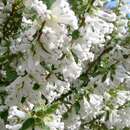en
names in breadcrumbs



Leucopogon oxycedrus is a species of flowering plant in the heath family Ericaceae and is endemic to the south-west of Western Australia. It is an erect shrub with variably-shaped leaves with a small, sharp point on the tip, and white, pink or red, tube-shaped flowers.
Leucopogon oxycedrus is an erect shrub that typically grows to a height of 0.1–1 m (3.9 in – 3 ft 3.4 in) and often has spreading branches. Its leaves are sessile, 6–12 mm (0.24–0.47 in) long, linear, oblong or lance-shaped, sometimes egg-shaped with the narrower end towards the base, but with a small, sharp point on the tip. The flowers are usually borne singly or pairs in leaf axils on a short peduncle with tiny bracts, and broad bracteoles less than half as long as the sepals. The sepals are about 3 mm (0.12 in) long, the petals white, pink or red, nearly 8 mm (0.31 in) long and joined at the base, forming a tube much longer than the sepals. Flowering occurs from March to December.[2][3]
Leucopogon oxycedrus was first formally described in 1845 by Otto Wilhelm Sonder in Lehmann's Plantae Preissianae.[4][5] The specific epithet (oxycedrus) is a reference to the prickly cedar, Juniperus oxycedrus, apparently because of the sharp point on the leaves.[6]
This leucopogon occurs in a variety of soils in near-coastal sites, in wetland, and on hills, ridges and breakaways in the Avon Wheatbelt, Esperance Plains, Jarrah Forest, Mallee, Swan Coastal Plain and Warren bioregions of southern Western Australia.[7]
Leucopogon oxycedrus is listed (as Styphelia erubescens) as "not threatened" by the Western Australian Government Department of Biodiversity, Conservation and Attractions.[7]
 Red form on Bluff Knoll
Red form on Bluff Knoll Leucopogon oxycedrus is a species of flowering plant in the heath family Ericaceae and is endemic to the south-west of Western Australia. It is an erect shrub with variably-shaped leaves with a small, sharp point on the tip, and white, pink or red, tube-shaped flowers.